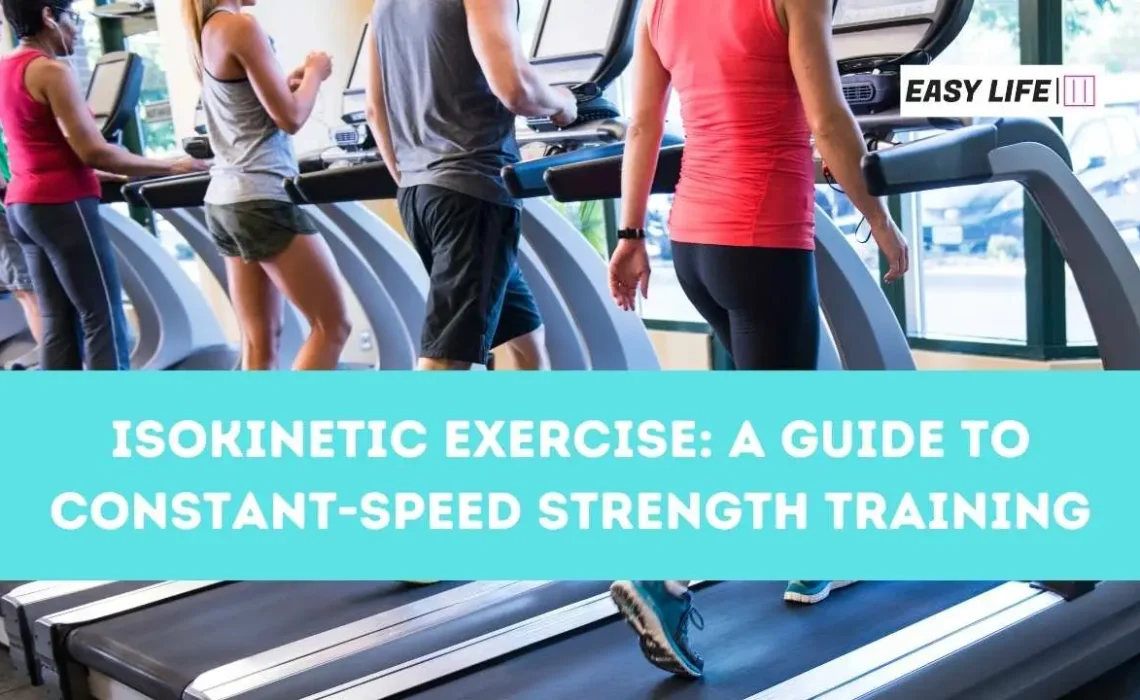Isokinetic exercise is a special kind of strength training where you utilise specially designed machines to move at a consistent speed no matter how much effort you put in. By adjusting the resistance to match your force output, the machine makes sure that your muscles are working as hard as possible throughout the duration of the exercise.
Table of Contents
ToggleUnderstanding Isokinetic Exercise
Isokinetic exercise, based on the premise of keeping a constant speed throughout the whole range of motion, provides a distinct and specialised form of strength training. Unlike traditional exercises, isokinetics ensures that muscles exert optimum force regardless of joint angle, resulting in balanced muscular development.
The Mechanics Behind Isokinetics
Isokinetic devices
Isokinetic exercise frequently employs specialised instruments designed to produce regulated resistance. These devices modify resistance in real time to accommodate the user’s force output, ensuring a consistent speed of movement.
Muscle Engagement
Isokinetic exercises work both the agonist and antagonist muscles at the same time, increasing muscle strength as well as endurance. This simultaneous activation provides a holistic workout experience, making isokinetic exercise a popular choice among athletes and fitness aficionados.
What are the benefits of isokinetic exercise?
There are several benefits to using isokinetic exercise, including:
- Improved muscle strength and power: Isokinetic training can help you to build muscle strength and power more effectively than traditional weight training, as it ensures that your muscles are always working at their maximum capacity.
- Reduced risk of injury: Isokinetic machines provide controlled and stable movement, which can help to reduce the risk of injury, especially for people with joint pain or instability.
- Enhanced rehabilitation: Isokinetic exercise is often used in physical therapy to help people recover from injuries or surgeries. The controlled nature of the movement can help to protect healing tissues while still providing a safe and effective way to rebuild muscle strength and function.
- Improved balance and coordination: Isokinetic exercises can help to improve balance and coordination by challenging the muscles in a way that traditional weight training does not.
Who can benefit from isokinetic exercise?
Isokinetic exercise can be beneficial for people of all ages and fitness levels. It is especially beneficial for:
- Athletes who are looking to improve their performance
- People who are recovering from injuries or surgeries
- People with chronic conditions such as arthritis or osteoporosis
- Older adults who are looking to maintain their muscle strength and function
What are the different types of isokinetic exercises?
There are many different types of isokinetic exercises that can be performed on a variety of machines. Some of the most common exercises include:
- Leg extensions and hamstrings curls
- Knee flexion and extension
- Shoulder flexion and extension
- Elbow flexion and extension
How do I get started with isokinetic exercise?
If you want to try isokinetic exercise, you should start with a competent instructor, such as a physical therapist or professional strength and conditioning coach. They can assist you in selecting the appropriate workouts and machines for your specific needs and goals.
Isokinetic Exercise vs. Traditional Strength Training
Constant Resistance vs. Variable Resistance
Isokinetic exercise is fundamentally different from traditonal strength training, in which resistance varies throughout the range of motion. This important distinction guarantees that isokinetic workouts create a more controlled and predictable environment for muscle engagement.
Adaptive Resistance
Traditional exercises rely on external weights, while isokinetics adapts resistance dynamically. This adaptability ensures that muscles are continually challenged, promoting a more comprehensive and efficient workout.
Here are some additional tips for getting started with isokinetic exercise:
- Start with a light weight or resistance and gradually increase the intensity as you get stronger.
- Focus on maintaining good form throughout the exercise.
- Do not try to push yourself too hard.
- Listen to your body and take rest days when needed.
It can be a safe and effective way to improve your strength, power, and overall fitness. If you are looking for a new challenge, give it a try!
Conclusion
Finally, isokinetic exercise emerges as a dominant force in the field of constant-speed strength training. Its distinct mechanics, focused muscle engagement, and adaptability distinguish it as an excellent addition to any exercise routine. This exercise is a diverse and effective alternative for anyone looking to rehabilitate from an injury, increase speed and power, or grow general muscle mass.
I hope this article has been helpful. If you have any questions, please feel free to leave a comment below.
Additional resources:
- American College of Sports Medicine: https://www.acsm.org/
- National Strength and Conditioning Association: https://www.nsca.com/
- Mayo Clinic: https://www.mayoclinic.org/









